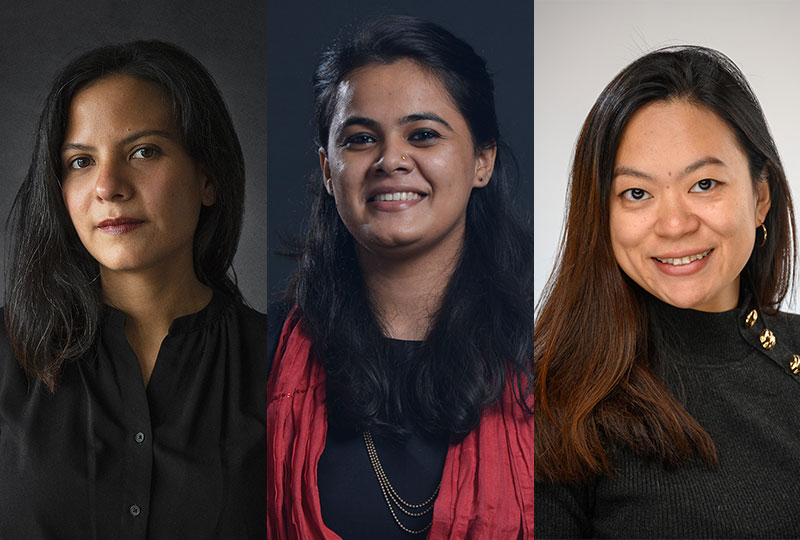
2024 SAH IDEAS Research Fellows Maria Alejandra Linares Trelles, Saman Quraishi, and Hongyan Yang
The Society of Architectural Historians is pleased to name Maria Alejandra Linares Trelles, Saman Quraishi, and Hongyan Yang as the recipients of the 2024 SAH IDEAS Research Fellowships, which support research that challenges existing paradigms and represents under-recognized directions for architectural history. Intended for emerging scholars, the $1000 fellowship award also includes one year of close mentorship from a senior colleague from the SAH community as well as guided lateral interaction across the cohort to encourage peer support.
Maria Alejandra Linares Trelles is an architect based in Washington, DC, and New York. She works across design, research, and curatorial practices, and currently teaches studios and seminars at The New School, Pratt Institute, Columbia University, and Universidad Andres Bello. She holds a professional degree in architecture from Pontificia Universidad Catolica del Peru and an M.S. in Critical, Curatorial, and Conceptual Practices in Architecture from Columbia University – GSAPP.
Her work examines the sociopolitical forces shaping the built environment with a focus on architecture’s complicit role in constructing landscapes of extraction. Her current research project focuses on the San Lorenzo Valley, located in the northwestern region of Peru and an important site for agroindustry. A previously dry area, it became agricultural land during the second half of the twentieth century after a series of infrastructure projects diverted water from the Chira River basin to the Piura River basin. The Peruvian government, in cooperation with international actors including the World Bank, USAID, the Institute of Inter-American Affairs, and the Morrison-Knudsen company, led projects that included canalizing the Quiroz River, constructing dams, and the San Lorenzo Irrigation and Land Settlement Project. In a context of profound inequality, the creation of the San Lorenzo Valley emerged as a pilot program for land reform on the continent. However, it quickly catalyzed multiple conflicts around water rights between cotton plantation owners, small farmers, Indigenous communities, and, more recently, agribusinesses. Her project draws connections between water, landscape, food ecologies, developmentalism, and global economies to expose the systems of power driving territorial transformations, while examining their environmental implications in the face of climate vulnerability.
Saman Quraishi is an architect and historian who currently works as an assistant archivist at CEPT Archives in India. She is an Active New Professional of the International Council on Archives (ICA) as a part of the New Professional Programme (NPP) 2022–23. Her professional undertakings and endeavors are situated at the confluence of archival research practice. She believes in the creative, integrative, and transversal use of archives. She holds a Master of Architecture from CEPT University.
Her current research explores ways in which architectural archives shape themselves and become entry points for negotiating the complexities of architectural history. Her interest and focus lie in organizing and curating archival collections to enhance discoverability, accessibility, and inclusivity. Her research aims to develop a pedagogical framework through which expansive and diverse visual resources, specifically architectural archives, can be used as active bodies of knowledge and allow for critical thinking and learning. Her research explores the collections she works with at the CEPT Archives, one of the first architectural archives in India, to underline and posit the ways in which architectural production in the post-independence era is perceived, represented, and presented through the process of archiving. It questions the constraints and opportunities inherent in archival methods and their impact on engaging with architectural histories. The inquiry maps out the conjunctions of the archival processes of select collections in relation to the anticipated expectations of possible archival engagements. Her research focuses on mapping anchor points that can create a bridge to ensure the archives are considered an integral part of the architectural production itself and not as a separate entity that is out of the scope of the nature of architectural production.
Hongyan Yang is a Core Fellow/Visiting Assistant Professor in History, Digital Humanities, and Comparative Migration and Ethnic Studies at Boston College. She holds a Ph.D. in architecture from the University of Wisconsin-Milwaukee. As an interdisciplinary, activist-scholar trained in urban planning, human geography, and architectural history, she centers the built environment in the research and empowerment of Asian American communities. Her main areas of research include placemaking through art and architecture, ethnic food landscapes in America, the architecture of Chinatown, and community-engaged oral history. Building primarily on artifactual evidence, spatial ethnographies, and archival research, her work uncovers the often-unknown lived experiences of Asian immigrants and Asian Americans dating back to the late nineteenth century, exploring how their racial consciousness, cultural sensibilities, and shifting positionalities invest new meanings into the cultural landscapes of the United States.
Dr. Yang is working on her first book manuscript, Landscapes of Resistance: Chinese Placemaking across the Pacific. This book intervenes in an agency-oriented theoretical discourse that interrogates the connections between racial politics and the social actions that Chinese immigrants undertook to resist racial dominance in their daily lives from 1880 to 1950. To confront the chief methodological challenge of lacking first-person accounts by Chinese immigrants in institutional archives, Yang has unearthed new evidence from architectural archives and food material culture in addition to oral histories. She uses the term “placemaking” to underline tactics that were often ephemeral, discrete, and sometimes intangible, but nevertheless allowed Chinese immigrants to contest the racial hierarchies embedded in the built environment. Furthermore, Yang reveals that these actors’ placemaking practices—contingent on their situated and negotiated identities—varied based on spatial scales, building types, ownership, and transnational contexts. In doing so, she aims to facilitate deeper examinations of Asian American spaces to contribute to debates on immigrant agency and play a vital role in shaping a more inclusive interpretation of architecture.